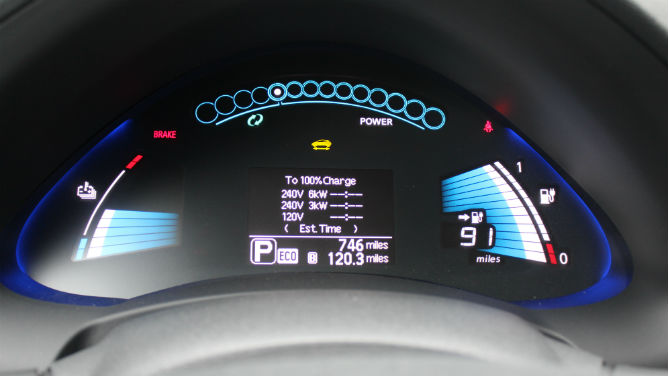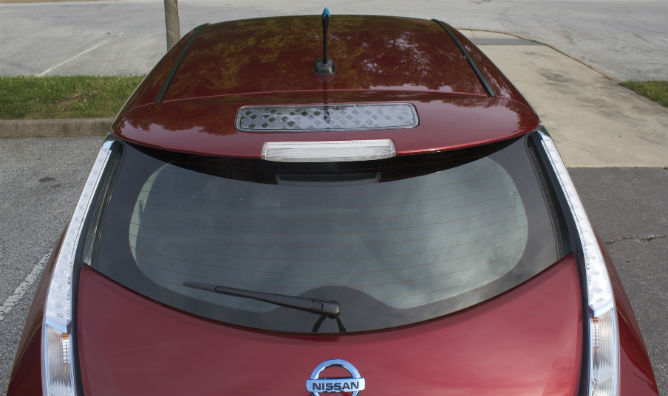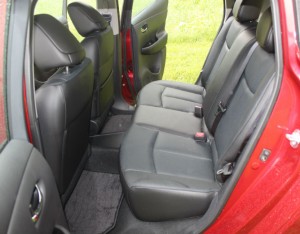
Base MSRP: $28,800

Although Nissan’s all-electric Leaf has been on the market for two-and-a-half years, and returns updated for 2013, many Americans remain unaware of its existence, and others do not have a firm grasp of its pros and cons.
Obviously, many do know about the electric vehicle (EV) and this year Nissan set sales records in March, April, and May since beginning Tennessee production this year.
To augment its appeal, Nissan slashed all Leaf trim level prices and introduced an S version that’s $6,000 less than the lowest priced 2012 model.
The Leaf is thus more than ever a standout. It is the only mid-sized five-passenger purpose-built all-electric car sold in America starting at under $30,000 and one of only three sold in all 50 states.
Nissan’s brash CEO Carlos Ghosn is betting billions – and risking his reputation – to prove that despite criticism, misunderstanding, and an entrenched addicted-to-oil paradigm, zero-emissions EVs can make sense now.
According to averaged U.S. Environmental Protection Agency, electricity to power a Leaf would cost the equivalent of an inflation-protected 87 cents per gallon of gasoline if one chose a Leaf over a 25 mpg gas-powered car.

A fully charged battery displays in excess of EPA-estimated range. With moderate city/suburban driving, this 91-mile estimate or higher may be attained. Fast starts, longer highway stretches and speeding above highway limits will degrade ultimate range. You soon learn the boundaries.
Not-as-great news is the Leaf’s 84 miles of estimated range with a full charge lags the 250-350-plus mile range of internal-combustion cars. Intra-day charging can however increase the Leaf’s range to 120-200 miles. Also in the public’s eye is its $29,650 (including destination fee) starting price. While this is $1,260 less than the $30,910 average new car price, some say this is still too much.
Positively speaking, the Leaf offers several unique benefits. It is eligible for a $7,500 federal tax credit and various state-by-state incentives which can significantly reduce price sting. People have found the Leaf can “pencil out” as a fair tradeoff.
And, of course, it is very positive for the environment and paves the way for more paradigm-upsetting developments to come.
Nissan says it listened to existing Leaf drivers in introducing the decently appointed but less pricey S trim level while simultaneously increasing features and cutting prices for the now mid-level SV and top-line SL.
Standard on the S (and all models) is a heated leather-covered steering wheel (apologies – we got our info crossed in initially saying it was optional in the video). Also on the S are a 4.3-inch touch screen, charging and energy data readout, keyless entry, heated front and rear seats, power accessories and Bluetooth connectivity. It gets last year’s slower 3.6-kw onboard charger, but optional is the 6.6-kw charger that’s standard on SV and SL (see price sheet below).

A solar panel added this year to the SL makes use of space while delivering a small amount of current to power accessories.
Among new and optional features for the SV and SL are a standard 7-inch touch screen and several higher-line updates, such as leather heated seats, and an “Around View Monitor” with cameras showing a 360-degree perspective and 7-speaker Bose® energy efficient audio.
Further, an “Eco route” was added to the available navigation system that includes suggested power-saving alternative routes, Google local search, Pandora for iPhone and iPod cover art.
Also this year is a “B” drive mode to increase regenerative braking. Touches like a charge port light and lock, remotely operated charge port door, new black interior color and sun visor extensions add to a mid-cycle refresh too detailed to comprehensively list.
Carried over is the electric driveline, however. It’s now assembled in Decherd, Tenn., an hour from the Smyrna assembly plant and new battery assembly plant next door presently loping along with 20-times more production capacity than Nissan needed for 2012 Leaf sales – Nissan and Infiniti obviously have big future EV plans!
The front-wheel-drive Leaf’s 80-kw AC synchronous motor delivers 107 horsepower and 187 electrically limited pounds-feet of torque – 20 pounds-feet down from 207 last year to save juice and stretch range. Propulsion is via a single-speed gear reduction transmission.
Other energy savers include a new hybrid heating system, coefficient of drag cut from 0.29 to 0.28, and “Eco” drive mode which further reduces electrical draw.
Energy delivered by a slightly reformulated 24-kwh Li-ion battery is the same this year, but Nissan’s engineers upped range and miles per gallon equivalent (MPGe) to 115 combined, 129 city, and 102 highway thanks to what we call the Apollo 13 treatment.
(If you’ll recall, battery powered Apollo 13 was damaged and NASA scrambled to minimize amperage draw to get it safely home. Though the stakes were far lower, this is loosely analogous to Nissan’s wringing efficiency from the Leaf’s existing architecture.)
EPA-rated range on the window sticker says 75 miles with a 90-percent charged battery. With a 100-percent charge, rated range is 84 miles – 14 percent higher than 73 miles declared for 2011 and 2012 with 100-percent charge.
Nissan’s estimates to replenish a fully drained battery are:
• via DC Quick Charger: 80-percent full charge in 30 minutes
• @240 volts with 6.6-kw charger (6.0-kw output): ~ 4 hours
• @240 volts with 3.6-kw charger (3.3-kw output): ~ 7 hours
• @120 volts via included trickle charger: 21 hours.
The Leaf is sized between a Nissan Altima and Versa, It has a 106.3-inch wheelbase, 175.0-inch length, 69.7-inch width and 61.0-inch height.
All models get heated mirrors, and the tall vehicle’s aerodynamic profile is respectable, but not as slippery as the 0.25-cd Toyota Prius hybrid, and 0.24-cd electric Tesla Model S costing twice as much.
The Leaf’s “iconic” shape was originally chosen at the request of focus groups, and intended to make a statement. Whether you like it, think it’s unattractive, or are indifferent, it arguably makes sense at this point to stand out.
We think it looks handsome enough, kind of frog-like with bulbous headlights like peering eyes, and others have said it is attractive, especially considering what it represents.
The Leaf gives up nothing to modern automobiles, and provides a comfortable, acceptably roomy environment front and back that’s laden with technology and safety.
All models receive 6-way manual driver’s seat, 4-way manual front passenger’s seats, trip computer showing instant and average energy consumption, driving time, outside temperature and range.

Other standard features include Automatic Temperature Control (ATC), center console storage.
Rear cargo space is now 24 cubic feet with rear seats upright as the formerly trunk-mounted on-board charger was relocated under the hood. With the standard 60/40-split rear seat folded down, cargo space is 30 cubic feet.
A mental readjustment is needed to learn to work around the Leaf’s range and limited public charging, but drivers are rewarded with a fun-to-drive car that is “normal” if not also “neat” in most respects.
We’ve seen reviewers pan its perhaps 10 second 0-60 mph time as mediocre, but this is a commuter car. With full torque from 0 rpm, it is as peppy as anyone needs to 35 and even to 50. On the highway, it can still gallop OK, but aerodynamic drag does diminish range faster than around-town driving. Its natural habitat can include some freeway usage, and 95 mph is possible, but higher speeds sap energy much more quickly.
That said, on a 62-mile round trip mostly in Eco mode, we traveled a good 80 percent at highway speeds, and returned with 20 miles indicated range remaining. We kept speeds legal, and ran A/C intermittently.
The Leaf rewards sedate driving; finite power supply reinforces the need to keep it tame, but it is not lame.
Also on the positive side, the Leaf’s operation is as hushed as only Rolls Royce might have hoped for in another generation. A low-speed pedestrian warning sound and pulsed space-shippy back-up tone make you feel like you’re in a sci-fi movie.
Braking and cornering are “normal” as well for a mid-level hatch, and with its center of gravity low, the Leaf conceals its 3,256-3,340-pound-pound curb weight admirably.
The back-up camera in models so equipped is handy too, and our $36,9190 SL with the Around View Monitor offered front and side views at low speeds to assist spatially challenged drivers – hey, no judgment, but you (hopefully) know who you are.
Trolling down the road, reduced-power Eco and “B” regen-enhancing modes can be engaged on the fly, and the effect from either is immediately felt. When driving in “D,” pressing the Eco button feels like someone pulled a spark plug wire from a gas-powered car, and propulsion power is reduced by maybe 20-25 percent. Conversely, going from “B” to “D” feels akin to a mild turbo kicking abruptly on.
To maximize range, we actually found ourselves preferring Eco as it delivered acceptable around-town and highway acceleration. According to Nissan’s Corporate Communications Senior Manager, Brian Brockman, the way Eco actually works is an actuator pushes back on the accelerator pedal, which typically decreases acceleration. If you press the pedal down harder, the same amount of power is still available. Eco mode widens the range at which the regeneration system is active, which results in slightly more aggressive deceleration and braking feel. It also will run the HVAC in Eco mode to assist in energy conservation.
As is true for other cars so equipped, the “B” mode is really too strong to coast down a 6-percent grade unless you plan to continually decelerate, but on steeper hills it works fine. Comparing its effect again with an internal-combustion car, “B” feels like a downshift or two with attendant engine braking. It is best used when decelerating or stopping, and it illuminates more green regen-indicating circles in the power display – free energy! A similar result can be had by touching the brakes in “D.”
Other nuances to the energy supply picture can be seen in how the available range readout changes up or down when switching to Eco or B or D modes, or when tapping energy with the air conditioning or heater.
Sitting at a light with 62 miles range indicated, switching the A/C on instantly readjusted the range to 55 miles estimated. Turning the A/C off returned range to 62 and this is with the car stopped. Similar results happen in motion or stopped when you switch to Eco – range increases, or D – range decreases. And, if you switch to “B” that too affects the estimated range. The LED headlights in our SL did not diminish range when turned on.
Early Leafs were criticized for wildly inaccurate readout and owners would call it a “guess-o-meter.” Nissan has since improved the algorithms, but it’s not infallible.
It’s pretty good though, and sometimes with a fair amount of regenerative energy return, one can even see the range estimate increase a mile or two or more. This is a neat feature, like reversing the fuel gauge on a gas car. We’ll keep you posted when petrol burners start refining their own fuel onboard too.
Overall, the Leaf experience includes novelty that does not wear off overly soon.
As is true of any car, the answer is as follows: Yes, no, or maybe.
If you can get your mind around what the Leaf can do, and can make it work for your circumstances, it can be rewarding.
The Leaf costs less than the similarly specified, limited-market $40,000 Ford Focus Electric. Ford’s more conventional looking hatchback is a converted gas car but has one notable advantage: its battery thermal management system is liquid heated and cooled.
Nissan’s in-floor battery can pre-heat but is air cooled. Nissan’s omission of liquid cooling has gotten it into hot water with some early adopters in Arizona, Texas and California. Nissan never admitted any defect, did assign an independent review panel to investigate. This year Nissan’s warranty was expanded for 5 years/60,000 miles, which ever comes first to give owners some recourse if battery capacity decreases to nine out of 12 bars.
Another concern is the fact that all battery powered cars lose potential range over the years, whether only a few miles, or more. Also, one must have home charging, ideally, 240-volt, and those who lack this option have a daunting disadvantage,
Some people choose leasing to hedge against future range loss and technology improvements. Resale values are less easy to calculate and lease rates can be attractive to the point of nearly netting a free car.
Is that hype? No, but it depends whether it will pan out. As one example goes, the Leaf could look financially attractive if one leased it for $199-$299 a month or less with $1,800 down (more or less). If a lease customer previously spent $250 or more per month on gas, while electricity costs must be accounted for, real world Leaf owners have discovered cost-to-operate to be inexpensive to a virtual wash.
Other electric alternatives include the gas-electric Chevrolet Volt, smaller, limited-market Chevrolet Spark EV, plainer and less costly Mitsubishi i-MiEV, or at least twice-the-price Tesla Model S. If the Leaf is likened to a sensible electric Toyota Corolla, the Model S is like a have-it-all electric Porsche Panamera S turbo.
A decision to go with the Leaf should be carefully analyzed, but while fear, uncertainty and doubt abound, dealers in Portland have reported monthly Leaf sales exceeding those for vehicles up to the top-selling Altima.
Information is your friend, and only you can decide whether the Leaf is a wise decision. Aside from these qualifiers, we are certain many more people would benefit from the car than are presently, and Nissan is definitely committed to it as much as, or more than, any other automaker.
The Leaf in a Nutshell
The Leaf is essentially a normal hatchback that comfortably seats four, can make it with five, has decent storage capacity – but has maybe a 3.5 to 4.0 gallon “gas tank” (battery). Replenishing this energy supply takes up to four hours at 240-volts with the 6.6-kw on-board charger. (This is compared to an imaginary internal combustion car’s 25 mpg multiplied by 3.5 = 87.5 miles easily attainable range. On a slower route, the Leaf might be good for 90-100 miles or more).
A decreased “fuel” supply that takes longer to refill may not sound too flattering for a $29,600- $37,000 car (before substantial potential subsidies), but while we’re imagining, imagine the Leaf’s “fuel” costs maybe one-fifth what you’d pay for gas – an energy source that’s getting comparatively more expensive as years go by.
Figuring Actual Cost To Power A Leaf
A reliable formula to calculate your actual cost of “fuel” (electricity) is to divide miles driven by MPGe (129 city, 102 hwy, 115 combined) and multiply by 33.7 (33.7 kwh=energy of one gallon of gas). Then use your actual electricity cost to calculate your actual operational cost.
The EPA figures electricity at 12 cents per kw and calculates based on 15,000 mile per year.
For simplicity’s sake, and to compare to an imaginary 25-mpg gas car, let’s figure 10 cents per kilowatt and cost to travel on one gallon of gasoline, or 25 miles.
Specifically, you can divide 25 miles driven by the combined 115 MPGe and multiply by 33.7. This equals your actual kwh consumed.
In this case, kwh consumed = 7.33.
Take 7.33 times your actual price per kw (10 cents in this example). This equals about 73 cents to drive 25 miles. A 25 mpg gas-powered car would use one gallon of gas at say $3.75 per gallon.
The Leaf’s hypothetical 73 cents per gallon cost is one-fifth the $3.75 per gallon of a comparable hatchback.
Summation
Can you live with a small fuel tank if you get an inflation-protected 73 cents per gallon “fuel” price? (At 12 cents per kilowatt, it’s 87 cents). What’s more, there are places where public chargers let you fill for free (like your Nissan dealer’s quick charger!) This would further reduce your “fuel” costs. Of course, some public chargers do require a fee, and at higher electric rates, and in these cases, you will pay more.
To make it work from a dollars-and-sense viewpoint, the Leaf must be driven enough miles to offset the electric car’s price premium over a comparable gas car.
This does not account for how you will also benefit the environment, and contribute to a solution that needs consumer acceptance to reach critical mass.
Throw in being able to recharge mostly during off hours at home and the fact that the car is just plain fun to drive and you could have a winner.